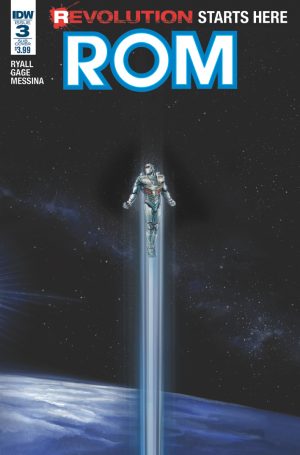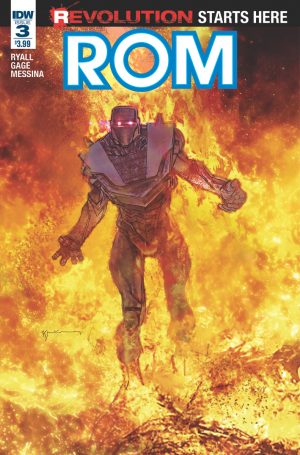Review: ROM #3
The third issue of a comic book sometimes feels like the hardest issue to write about—maybe even worse to review. The average comic reader knows by the end of issue two whether they’re going to keep up with something and, in a market driven by five-issue story arcs, the third issue typically has the least going on. There’s no excitement of a new premise as in issue one. There’s no familiarization with characters as in a second issue. We’re a stone throw’s away from any dramatic plot twists of a fourth issue and even further from a satisfying conclusion of a fifth. The third issue then becomes a type of storytelling buffer—this repetition of character and story beats intended to build towards the actually exciting chapter. Yet despite these issues' stagnant nature, without these narrative safety nets, you get a glimpse of the true quality of the story being told.
This has been a long way to simply say: I’m worried about the future of IDW’s Rom series.
 We pick up a couple seconds from where the last issue left off—Rom’s been momentarily captured by the Dire Wraiths but this time with a new ally—Camilla Beyers, a human now half-corrupted into a Dire Wraith. Camilla’s pretty new to the whole Dire Wraith-Spaceknight conflict so as the Wraiths have them captured they propose a new narrative to this story.
We pick up a couple seconds from where the last issue left off—Rom’s been momentarily captured by the Dire Wraiths but this time with a new ally—Camilla Beyers, a human now half-corrupted into a Dire Wraith. Camilla’s pretty new to the whole Dire Wraith-Spaceknight conflict so as the Wraiths have them captured they propose a new narrative to this story.
See, the Dire Wraiths are really the victims here—they’re refugees of a galactic war and who came to Earth when they had nowhere else to go. They’ve lived here in peace for centuries alongside the humans and these casualties and deaths have only happened because Rom’s brought the war back to them.
Elsewhere, the former soldier Darby is found and taken back to civilization by who she believes are humans. Only Darby learns she can never go back again—not with this new knowledge, not with this constant paranoia in whether people are who they say they are.
This alternate narrative proposed by who are traditionally the series villains is an attractive one. There’s a straightforward morality to the nature of the past Rom canon. He was a character driven by his morality—this unconquerable rightness in his patriotism. After all, in that iteration his people were pacifists before the Dire Wraiths and the Spaceknights were a reaction to the attacks they suffered.
But maybe here Rom’s people were the not utopian society of Mantlo’s story. Maybe here, we as readers are missing something fundamentally important to understanding the nature of this war. As Rom recruits Camilla and Darby to his effort against the Dire Wraiths he openly acknowledges it as enlisting. He openly tells Camilla that he wants to turn her into a spy for him instead of curing her of a fatal disease. The Rom here is more alien than ever before and that makes it more questionable whether he’s really the good guy here.
These aspects are interesting, even exciting on a conceptual level in how you adapt and reinvent the story of Rom for modern day but there’s something lost in the presentation.
 Rom #3 carries on primarily two different modes of storytelling—an action panel and a dialog panel. While two pages in the issue break this mold and succeed, the majority is dominated by fight scenes and exposition. When the Dire Wraith explains their side it is nearly impossible to believe in part because we're being told this by a terrifying lizard wizard but also because it’s largely done through speechifying.
Rom #3 carries on primarily two different modes of storytelling—an action panel and a dialog panel. While two pages in the issue break this mold and succeed, the majority is dominated by fight scenes and exposition. When the Dire Wraith explains their side it is nearly impossible to believe in part because we're being told this by a terrifying lizard wizard but also because it’s largely done through speechifying.
The original run of Rom Spaceknight featured a very similar story albeit on a smaller scale. One Dire Wraith, grown so tired and fearful of the drawn-out war, decided to desert it and hide on Earth. You could feel the genuineness of his character as you watched him try to seek acceptance from locals, fall in love, and experience the worried fear of raising a child. Mantlo drew upon the imagery of draft dodging during the Vietnam War and created a parallel with someone finding a new life in a foreign country out of fear.
There’s moment of humanity like this in Rom #3. A quick two-page scene where Darby, boarding a bus, imagines everyone on it secretly a Dire Wraith and, as the bus pulls away, she tries to determine the moment her family was killed. The scene here plays out like a subtle processing of the character’s own post-dramatic stress disorder and dealing with a delayed sense of loss. This moment is convincing and human but lost between the intergalactic stakes of the story.
An issue like this one makes me wonder if why I liked the original Rom Spaceknight is ultimately different from why others did. As it stands, I’m getting worried about IDW’s new version of Rom. The story here almost feels lost within its inter-connected world and its intergalactic conflict—more interested in big set-pieces and big stakes than thematic and character elements.
Rom barely feels like a character in his own story—there is little personality and history to him outside of talking funny and not knowing stuff. And that problem feels endemic to this comic as a whole.
Once we dive into Rom #3, there’s a distinct lack of something at its narrative center—a human heart to balance out its strange and elaborate exterior.
[su_box title="Score: 2/5" style="glass" box_color="#8955ab" radius="6"]
Rom #3 Writer: Chris Ryall Artists: David Messina and Michele Pasta Publisher: IDW Publishing Price: $4.99 Format: Ongoing; Print/Digital[/su_box]
[/su_box]
